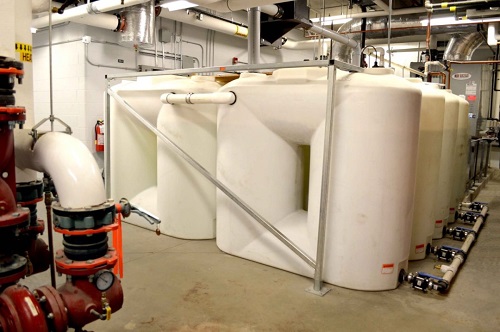 Thursday, April 25, 2024
Thursday, April 25, 2024  Thursday, April 25, 2024
Thursday, April 25, 2024 
There’s no doubt that we can all do a better job when it comes to water conservation — and indoor ice arenas, in particular, can have a tremendous impact on how water is used. Take the Abbotsford Centre in Abbotsford, BC as an example. In 2010, the Centre’s marketing team reached out to colleagues for ideas on how to lessen their demand on the local water supply. Chief Plant Manager Scott Currie suggested harvesting rainwater to build and maintain their ice — something that had never been done before. Incredibly, the two-year-old building turned out to be a perfect fit. At the start of the following hockey season, this 7,000 seat hockey-and-entertainment centre became the first professional grade indoor ice arena harvesting rainwater to build and maintain their ice.
Costing $27,000 and saving nearly a quarter million gallons of water annually, this is how they did it:
Managed by Spectra Venue Management, a division of Comcast Spectator, the marketing department took a good hard look at the facility’s water use. Were there any ways, they wondered aloud, that the Centre could lessen its demand on the local water supply? It’s a question they asked their entire team. Chief Ice Plant Manager, Scott Currie, had an idea that was unusual, innovative and bold. And, if it could work, it would reduce a great deal of the arena’s water supply demand.
It seemed, on the surface, like a brilliant win-win. But was the building a good candidate to make rainwater harvesting feasible? Currie was determined to find out.

Abbotsford, one of the half dozen or so cities that help make up the Greater Vancouver area, is in an incredibly good position for harvesting rainwater. With around five feet of rain per year, Abbotsford is shining as the wettest city in Canada. Those 60 inches of rain per year are compelling — especially for a rainwater harvesting project. One inch of rainfall on a 13,000 square foot section of roof would harvest 8,100 gallons of rainwater. Since an NHL-sized ice surface requires around 15,000 gallons of water for a 1.25″ thick sheet of ice, just two inches of rain is enough to build a sheet of ice from scratch.

There was another reason that Currie began investigating a rainwater harvesting solution. The arena’s water supply, sourced by a nearby creek, contained enough dissolved minerals, like calcium, to give them slow ice. Rainwater, the ice man reasoned, would result in a quicker, better surface.
As for the logistics of actually harvesting the rainwater, the Abbotsford Centre had all the makings for a perfect storm.
“We just happened to have everything in place that we needed to have,” Currie says.
“When I brought all of this forward to our building’s management, they said, ‘We can do something with this!” Currie says.
This rainwater harvesting system supplies nearly a quarter of a million gallons of water a year for used for building and maintaining their ice:
Because the harvested rainwater is stored in the warm (85°F) mechanical room, it’s pre-heated naturally. That reduces the Delta T needed to heat it up to 150°F to be used as floodwater. In fact, the system is requiring less energy than what it would cost to heat city-supplied water.
Barr Plastics Inc., the BC company that supplied the storage tanks, specializes in commercial rainwater harvesting systems. Partner Dean Barrett says the environmental impact of rainwater harvesting goes beyond saving water.
“Any rainwater that is collected and re-used is preventing water from going into the stormwater system and over-taxing our limited infrastructure,” Barrett says.
The other big improvement, Currie says, is the quality of the finished product.
“Our ice freezes quickly, and it’s a different ice to skate on,” he says. “I’d say it’s as close to skating on a natural pond as you can get.”
Dean Barrett says, “If you can tap into that collection capabaility, you can collect a lot of water!” If you’re interested in fitting, or retrofitting your arena with a rainwater harvesting system, here are some links you’ll find helpful:
And remember: using rainwater anywhere in your facility and especially for your ice is a great start. You can also use it in other areas such as toilets and urinals, cooling towers — even keeping your lawn nice and green in the summertime.